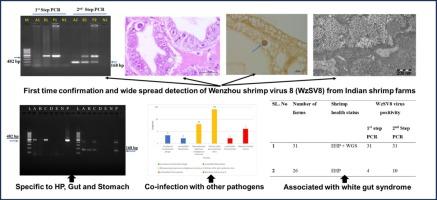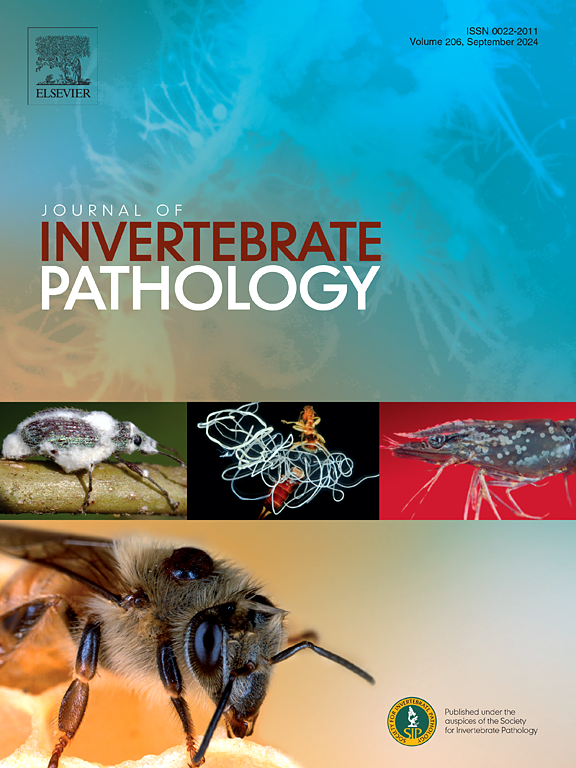Widespread detection of Wenzhou shrimp virus 8 (WzSV8) and it’s implication in cultured shrimp (Penaeus vannamei) farms of India
IF 2.4
3区 生物学
Q1 ZOOLOGY
引用次数: 0
Abstract
Like in other parts of world, Indian shrimp aquaculture industry is also suffering from diseases and mortalities and many of the pathogens have invaded into India. Here, an attempt was made to investigate the presence of newly described shrimp virus, Wenzhou shrimp virus 8 (WzSV8). More than 200 shrimp samples from different locations of India were collected and analysed for the presence of this virus. Widespread detection of WzSV8 was observed in shrimp farms of India where 58% of samples were found to be positive for this virus. Many of the samples had only WzSV8 infection and in others co-infection with other shrimp pathogens such as WSSV, IMNV and EHP were observed. Presence of WzSV8 was confirmed through PCR, histopathology, in situ hybridization, transmission electron microscopy and transcriptomics. To find out target organs for the detection of WzSV8, hepatopancreas, gut, stomach, gill and muscle were processed by PCR. Only samples from HP, gut and stomach were positive for this virus and muscle and gill were negative. A strong correlation of WzSV8 with shrimp white gut syndrome (WGS) was observed where WGS samples always had high load of this virus. Phylogenetically the Indian isolates were closer to Chinese isolates. The role of this virus in causing disease directly or precipitating the pathological conditions through co-infection needs to be studied further. Particularly, analysing the role of WzSV8 in shrimp white gut syndrome may provide clues about the disease mechanism

温州对虾病毒8 (WzSV8)在印度凡纳滨对虾养殖场的广泛检测及其启示
与世界其他地区一样,印度虾类养殖业也遭受疾病和死亡的困扰,许多病原体已经侵入印度。本文对新发现的温州虾病毒8号(WzSV8)进行了检测。从印度不同地点收集并分析了200多个虾样本,以确定是否存在这种病毒。在印度养虾场广泛发现了WzSV8病毒,其中58%的样本发现该病毒呈阳性。许多样品仅感染WzSV8,也有部分样品同时感染WSSV、IMNV和EHP等其他对虾病原体。通过PCR、组织病理学、原位杂交、透射电镜和转录组学证实WzSV8的存在。为寻找WzSV8检测的靶器官,分别对肝胰腺、肠道、胃、鳃和肌肉进行PCR处理。只有HP、肠道和胃样本呈阳性,肌肉和鳃呈阴性。观察到WzSV8与虾白肠综合征(WGS)有很强的相关性,WGS样品总是高病毒载量。在系统发育上,印度的分离株更接近中国的分离株。该病毒在直接致病或通过共感染诱发病理状态中的作用有待进一步研究。特别是,分析WzSV8在虾白肠综合征中的作用可能为了解其发病机制提供线索
本文章由计算机程序翻译,如有差异,请以英文原文为准。
求助全文
约1分钟内获得全文
求助全文
来源期刊
CiteScore
6.10
自引率
5.90%
发文量
94
审稿时长
1 months
期刊介绍:
The Journal of Invertebrate Pathology presents original research articles and notes on the induction and pathogenesis of diseases of invertebrates, including the suppression of diseases in beneficial species, and the use of diseases in controlling undesirable species. In addition, the journal publishes the results of physiological, morphological, genetic, immunological and ecological studies as related to the etiologic agents of diseases of invertebrates.
The Journal of Invertebrate Pathology is the adopted journal of the Society for Invertebrate Pathology, and is available to SIP members at a special reduced price.

 求助内容:
求助内容: 应助结果提醒方式:
应助结果提醒方式:


